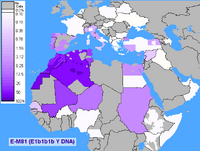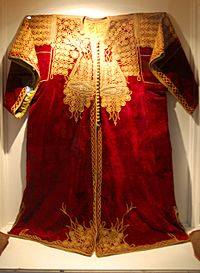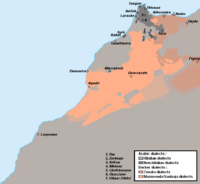Moroccans facts for kids

Map of the Moroccan diaspora in the world
|
|
| Total population | |
|---|---|
| +- 45 million worldwide | |
| Regions with significant populations | |
| 37,300,000 | |
| 1,314,000 | |
| 600 000 | |
| 1,000,000 | |
| 1.000.000 | |
| 530 000 | |
| 392,000 | |
| 100,000 | |
| 113,544 | |
| 103,945 | |
| 75,855 | |
| 70,000 | |
| 63,000 | |
| 60,000 | |
| 11,025 | |
| 10,500 | |
| 15,000 | |
| 9,000 | |
| 7,270 | |
| 7,000 | |
| 4,200 | |
| 4,000 | |
| 4,000 | |
| 3,500 | |
| 3,465 | |
| 3,400 | |
| 2,100 | |
| 1,800 | |
| 1,056 | |
| Languages | |
| Arabic (Moroccan Arabic, Jebli Arabic, Judeo-Moroccan Arabic, Hassaniya Arabic), Berber (Tashlhit, Tarifit, Central Atlas Tamazight, Judeo-Berber, Standard Moroccan Berber), Haketia, French, Spanish | |
| Religion | |
| Predominantly Islam (Sunni, Nondenominational Islam, Sufi); minority Judaism, Shia Islam, Christianity | |
| Related ethnic groups | |
| Other Maghrebis, Berbers, Arab-Berber | |
Moroccans are people who live in or come from the country of Morocco in North Africa. They share a common culture and history. The word "Moroccan" comes from the ancient names Moros and Moors.
Moroccans are a diverse group. Most have roots in Arab and Berber cultures. About 37 million Moroccans live in Morocco. Many others live in countries like France, Belgium, Israel, Italy, Netherlands, and Spain. There are also smaller groups in the United States, Canada, and the United Kingdom. A notable part of the Moroccan people living abroad are Moroccan Jews.
Contents
Moroccan History: Ancient Roots
The first modern humans in North Africa lived around 145,000 years ago. They created tools known as the Aterian culture. These tools were found at a site called Ifri n'Ammar in Morocco.
Later, the Iberomaurusian culture appeared. This group lived in prehistoric sites like Taforalt. After them came the Capsians. These early people were the ancestors of many North Africans.
Around 5000 BC, new groups arrived, bringing changes linked to the Neolithic revolution. Over time, these populations mixed. This led to the formation of the early Berber tribes.
Diverse Ethnic Groups in Morocco
Moroccans today are mainly a mix of Arab and Berber (also called Amazigh) people. This is similar to other countries in the Maghreb region. Some Moroccans are a blend of both, known as Arab-Berbers.
People's identity in Morocco is often linked to the language they speak. Moroccans live mostly in the northern and western parts of the country. They prefer the fertile areas near the Mediterranean Sea.
- Arabic-speaking Berbers include the Jebala in the north and Sahrawiyin in the southeast.
- Berber-speaking groups include the Riffians, Shilha, and Zayanes.
There are also smaller groups like the Haratin and Gnawa. These groups are farmers who live in southern and eastern oases. They speak either Berber or Arabic.
Around the 12th and 13th centuries, Arab tribes like the Banu Hilal and Banu Sulaym arrived in Morocco. They came from the Arabian Peninsula. Their arrival led to a wider spread of Arabic culture and language across Morocco. This was especially true outside the main cities.
Moroccan Ancestry and Genetics
Studies on the genetic makeup of Moroccans show a rich mix of ancestries. This reflects the long history of different groups living in and moving through the region. The main genetic influences come from both Berber and Arab populations. This mix is a result of thousands of years of human movement and interaction in North Africa.
Rich Moroccan Culture
Moroccan culture has been shaped by many influences over time. These include ideas from Europe, the Middle East, and sub-Saharan Africa. Morocco's culture shares many similarities with its neighbors, like Algeria and Tunisia. It also has some links to Spain.
Morocco has even influenced modern Europe in areas like architecture and farming. Moroccan numbers, for example, are now used worldwide. Each region in Morocco has its own unique cultural elements. The country works hard to protect its diverse heritage.
Traditional Moroccan Clothing
The traditional clothing for both men and women is called a djellaba. This is a long, loose robe with a hood and full sleeves. For special events, men might also wear a red cap called a fez. Women often wear beautiful kaftans decorated with ornaments.
Many Moroccans wear balgha, which are soft leather slippers without heels. They are often yellow. Women also wear high-heeled sandals, sometimes with silver or gold decorations.
Moroccan Architecture and Homes
Moroccan style is popular in home decoration. It comes from Moorish architecture. This style became well-known because of the many riad homes renovated in Marrakech. A Dar is a common type of home found in the old, walled parts of Moroccan cities.
Traditional Moroccan homes follow certain Islamic rules for domestic life. The outside of these homes usually has no decorations or windows. Small openings might be found in secondary areas for light and air.
Delicious Moroccan Cuisine
Moroccan cuisine is a blend of Berber, Moorish, and Jewish influences. It is famous for dishes like couscous and pastilla. Spices like cinnamon are very important in Moroccan cooking. Sweets like halwa are also popular. Food from neighboring areas has also added to Morocco's cooking traditions.
Moroccan Arts and Crafts
Moroccan craftsmanship has a long history. Artisans create beautiful items like:
- Jewellery
- Pottery
- Leather goods
- Woodwork
Vibrant Moroccan Music
Moroccan music is very diverse, with different styles across the country. It ranges from complex orchestral music to simple songs with just voice and drums.
- Berber folk music has three types: village music, ritual music, and music played by professional musicians.
- Chaabi is a popular music style that comes from various Moroccan folk traditions. It's often heard at celebrations.
- Gnawa is a mystical form of music. It was brought to Morocco by the Gnawa people and became a part of Moroccan culture.
- Sufi music is used by Sufi brotherhoods (called tarikas) in their spiritual practices. This music helps them reach a trance-like state.
Languages Spoken in Morocco
Morocco has two official languages: Classical Arabic and Berber.
Most Moroccans speak Moroccan Arabic. More than 12 million Moroccans also speak different Berber dialects. These include Riff, Shilha, and Central Atlas Tamazight.
Hassaniya Arabic is spoken in the southern part of Morocco. The country's constitution now protects this language.
French is widely taught and used in Morocco. It is the main language for business and economics. It is also common in education, science, and government.
Spanish is spoken by some people in northern Morocco as a foreign language. English is becoming more popular, especially among educated people in scientific fields.
Images for kids





